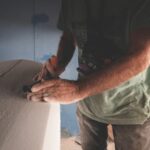Introduction
Woodworking safety glasses can offer protection to a woodworker’s eyes and face while working with saws, sanders, drills, and other power tools. They come in a variety of styles, sizes, and lens configurations which make them perfect for any application. Safety glasses protect the worker from flying debris, dust particles, harmful substances like lacquer or glue fumes that may be released during the woodworking process, as well as from any potential eye injuries due to contact with a tool’s moving components. Aside from protecting the worker against injury and irritation, these glasses also add an extra layer of visual clarity when working with precision pieces that require intricate work. In addition to providing a clear view field without distortion or blurriness around the edges of the lenses, they are available in frames designed specifically to fit comfortably while allowing freedom of movement when making precise measurements or cuts. These lenses often feature specialty coatings that provide enhanced protection against UV radiation damage as well as increased impact resistance than regular safety lenses would provide. Moreover, some manufacturers incorporate additional features such as built-in side shields or ventilation systems which further enhance the user experience by keeping dirt and debris out of their eyes while working long hours with tools that produces heat and vibrations. Finally, woodworking safety glasses enable workers to maintain their concentration on their tasks uninterruptedly and remain fully safe whilst spending countless hours crafting beautiful pieces in comfort and style.
Different Types of Woodworking Safety Glasses
Safety glasses for woodworking come in many shapes and forms, from protective spectacles to face shields. Basic safety glasses have tinted lenses that protect against UV rays as well as debris or dust. Most basic safety glasses provide some impact protection, but are not considered full-on safety goggles because they do not completely seal the eyes from potential hazards. Many styles also come with sideshields that keep chips and particles away from the eyes.
More specialized styles of drywork safety glasses include computer glasses which are made of polycarbonate lenses that help address glare caused by computer screens, as well as anti-fog styles which help workers who are using tools such as saws and drills in warmer environments where fogging can be an issue. For those working with more hazardous materials such as solvents, chemical resistant safety eyewear should be worn; these goggles comply with a variety of standards included ANSIZ87+. For extra hazard levels, full face shields might be necessary to fully protect employees. Finally for working with lasers, extreme duty laser protection spectacles are required which offer both impact and laser protection simultaneously.
Understanding the Different grades of Protection
Different types of woodworking require different levels of protection for your eyes. The main gradations you should understand are the American National Standards Institute (ANSI) Z87.1 grades or the European EN 166 Levels. The first one, ANSI, is a grading system from the United States based on impact and optical requirements while the latter one is based on a metric system coming from Europe.
ANSI Grade E – This is the lowest grade of safety glasses that meets modern standards and provides basic eye protection only suitable for very light duty sanding and grinding tasks as well as general laboratory use.
ANSI Grade D – Offers medium level eye protection suitable for occasional exposure to impact hazards such as flying debris in workshops or more strenuous task such as chipping with a hammer or sawing where protection against dusts, fumes, and liquid splashes are needed.
ANSI Grade C – These glasses offer enhanced eye protection similar to Grade D but with additional features like side shields or adjustable lens angles to provide wider peripheral vision. They will also protect from greater impact damage at higher pressures and speeds like during machining operations or using power tools such as circular saws, routers, etc.
EN 166 Level A – The highest grade of protection under the European grading system providing optimal impact resistance along with superior splash resistant lenses which protect eyes from hazardous liquid chemicals that could be present in most industrial settings. They also feature anti-fog lenses to keep your vision clear.
Advantages of Wearing Woodworking Safety Glasses
Woodworking safety glasses provide a level of protection that regular eyewear can’t. Woodworking environments are often filled with myriad hazards, such as sawdust, chips, and flyaway wood splinters. All of these airborne particles and debris represent potential risks to the eyes, which could lead to irritation or loss of vision. Wearing protective eyewear allows woodworkers to avoid these potential injuries by providing a barrier between their eyes and the hazardous environment.
In addition to protecting your eyes from physical harm, wearing woodworking safety glasses can also give you improved visibility when cutting objects. The lenses on these glasses are designed to reduce glare from natural light and improve focus on your workspace. This will help prevent mistakes and accidents caused by poor visibility when working with hand tools or power tools. Furthermore, in many industrial settings, wearing safety glasses is required for occupational safety guidelines; thus, it is important for all woodworkers who work within such settings to wear the proper protective eyewear.
Choosing the Best Woodworking Safety Glasses for Your Needs
When it comes to woodworking safety, you’ll want to make sure you have the right tools and equipment. One of those important items are safety glasses. Safety glasses protect your eyes from a variety of hazards while working with wood such as flying dust, chips, or splinters. It is important to select safety glasses which are comfortable enough to wear and offer the right level of protection for your specific needs.
It is recommended that any pair of safety glasses used for general carpentry and woodworking purposes have lenses made of polycarbonate. This material is very tough and provides an excellent level of protection against particles striking the eye. Another important feature of metal working safety glasses is that they should be impact resistant in order to better protect vision in the case of a flying particle or tool striking them directly. Additionally, look for safety glasses that have side shields or wrap-around frames. This can provide protection from objects being thrown towards the sides and from harmful UV light rays.
For specialized tasks such as welding, brazing, soldering or using a laser cutting machine, extra precautions should be taken by wearing additional eye protection such as goggles or face masks with protective lenses built into them. It is also important to make sure all lenses are kept clean since debris buildup can impair vision on even the highest quality lenses, potentially leading to accidents or injuries on the job site. In addition, tinted lenses should never be used when operating dangerous tools such as grinders or saws since they reduce visibility in already potentially hazardous environments.
Tips for Maintaining Your Woodworking Safety Glasses
When it comes to protecting your eyes while woodworking, safety glasses are an invaluable tool. Although wearing protective eyewear is great for preventing eye injuries, there are some steps you should follow to maintain the effectiveness of your woodworking safety glasses and make sure they provide optimal protection.
First and foremost, always keep them clean by wiping the lenses with a soft cloth or lens tissue. This will help ensure that the lenses do not become smudged or scratched and make it easier to fully see what you’re working on. Next, look out for the wear and tear that is normal with frequent use of glasses. You should replace them regularly to continue protecting your vision from dust and debris particles generated throughout your projects. Regularly check the lenses for any cracks or breaks in its structure as any damage can weaken their effectiveness.
It is also important that you store your woodworking safety glasses correctly in-between uses. If possible, always opt for a designated storage container as this can help protect them from scratches and dirt buildup when not in use. This will ensure that when you pick up your safety glasses again they are ready to provide maximum protection from would be eye hazards!
Popular Materials Used in Woodworking Safety Glasses
Woodworking is a craft that requires a certain level of protection to ensure the safety of its practitioners. Woodworking safety glasses are a protective eyewear meant to shield the eyes from sawdust, flying debris, and other hazards found in a woodworking setting. Popular materials used in these glasses include polycarbonate, plastic frames with shatterproof lenses, and impact resistant polarized lenses. Polycarbonate is an incredibly durable material that offers optical clarity and UV protection qualities. Plastic frames tend to be lightweight and offer comfort during use whereas shatterproof lenses may provide additional security in the event of an impact occurring. Impact resistant polarized lenses are also beneficial for increased visibility when performing different tool operations like routing or planing, as well as providing extra glare reduction. By equipping oneself with the proper eyewear when engaging in woodworking activities, one can help reduce the potential risk of injury and improve their overall shop safety experience.
Common Myths and Misconceptions About Woodworking Safety Glasses
1. Myth: Wearing safety glasses makes woodworking difficult or uncomfortable.
Fact: Modern safety glasses are designed for comfort, and feature adjustable temples and frames to fit varying face shapes—making them just as comfortable to wear as other eyewear. In fact, using a good pair of woodworking safety glasses can actually improve accuracy and reduce eye strain associated with woodworking tasks.
2. Myth: Safety glasses are fragile and easily broken.
Fact: Quality safety glasses are extremely durable and can withstand the toughest work conditions due to their impact-resistant lenses that protect your eyes from dust, debris, chemicals, wood splinters, sawdust, and more. Most frames also feature padding around the nose bridge area for added comfort while wearing all day long.
3. Myth: All safety glasses offer the same level of protection from hazards.
Typical safety glasses provide impact protection from flying objects—such as sawdust—but not protection from splash or continuous exposure to liquid hazards like chemical mixtures created in some woodworking tasks or environments (e.g., finishing work). Be sure to select a type of safety glass that meets the ANSI Z87 standard for the specific level of eye protection required by your work environment or situation. For maximum eye protection in any type of application or circumstance, goggles should always be worn instead of regular safety glasses
Conclusion
Woodworking safety glasses are an important piece of protective gear for any woodworker. They provide a barrier between your eyes and wood pieces and sawdust that can be propelled at a high velocity during the course of operations. The risk of flying debris, from saws or routers, can be greatly reduced by wearing the appropriate eye protection. Additionally, they will keep you from burning your skin with shavings or hot glue. Along with the physical hazard of splinters or slivers entering your eyes, safety glasses protect your sight from damage due to long-term usage and overexposure to ultraviolet light. All these factors combine to make wearing safety glasses an essential part of woodworking projects both large and small. Whether working on short-term hobbies or long-term projects, as a professional or serious amateur, it is in everyone’s best interest to don a pair before beginning work. With so much to gain and nothing to lose, investing in a quality pair of woodworking safety glasses is well worth the effort!

Hi everyone! I’m a woodworker and blogger, and this is my woodworking blog. In my blog, I share tips and tricks for woodworkers of all skill levels, as well as project ideas that you can try yourself.





